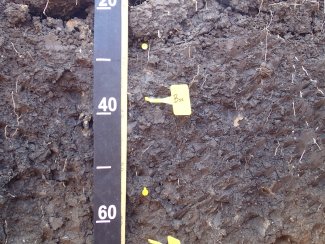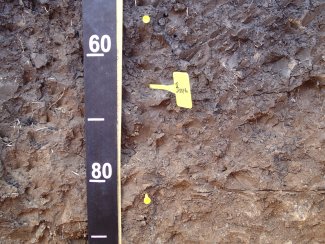Lajas Experimental Station NEON (LAJA) Soil Descriptions
Distributed Soils Reports
Pedon Descriptions
Pit‐level observations and field measurements reported using the standard NRCS format. They contain volume estimates for coarse fragments > 20 mm where applicable.
Site Level Plot Summary
A narrative summary that places the sampled soil pedons in the broader context of soils and geomorphology for the entire NEON site.
Megapit Images

D04 LAJA megapit soil profile 0-190 cm

D04 LAJA megapit soil profile 90-190 cm

D04 LAJA megapit soil profile 0-46 cm

D04 LAJA megapit soil 19-64 cm

D04 LAJA megapit soil profile 52-92 cm

D04 LAJA megapit soil profile 75-117 cm

D04 LAJA megapit soil profile 106-146 cm

D04 LAJA megapit soil profile 139-178 cm

D04 LAJA megapit soil profile 158-183 cm
Megapit Pedon Description
| Print Date | Apr 8 2015 |
|---|---|
| Description Date | Apr 8 2014 |
| Describer | Matos, Manuel |
| Site ID | S2014PR079001 |
| Site Note | Pedon description to support the Caribbean Basin NEON Project under the National Science Foundation. Local contact is Yamil Toro from San Juan, PR and science protocol contact is Rommel Zulueta from Colorado, USA. |
| Pedon ID | S2014PR079001 |
| Lab Source ID | KSSL |
| Lab Pedon # | 14N0430 |
| Soil Name as Correlated | Cartagena |
| Classification | Fine, mixed, superactive, isohyperthermic Sodic Haplusterts |
| Pedon Type | undefined observation |
| Pedon Purpose | research site |
| Taxon Kind | series |
| Associated Soils | Aguirre, Fraternidad, Guanica, Jacana, Santa Isabel |
| Physiographic Division | Caribbean Basin |
| Physiographic Province | Caribbean Islands Province |
| Physiographic Section | Greater Antilles (Puerto Rico) |
| Local Physiographic Area | Lajas Valley |
| Geomorphic Setting | on talf None Assigned |
| Upslope Shape | linear |
| Cross Slope Shape | linear |
| Particle Size Control Section | 25 to 100 cm. |
| Description origin | NASIS |
| Country | United States |
| State | Puerto Rico |
| County | Lajas |
| MLRA | 271 -- Semiarid Mountains and Valleys |
| Soil Survey Area | PR787 -- San German Area, Southwestern Puerto Rico |
| Quad Name | San German, Puerto Rico |
| Std Latitude | 18.0218444 |
| Std Longitude | -67.0760833 |
| Latitude | 18 degrees 1 minutes 18.64 seconds north |
| Longitude | 67 degrees 4 minutes 33.90 seconds west |
| Datum | WGS84 |
| UTM Zone | 19 |
| UTM Easting | 703677 meters |
| UTM Northing | 1993661 meters |
| Primary Earth Cover | Grass/herbaceous cover |
| Secondary Earth Cover | Tame pastureland |
| Parent Material | Tame pastureland |
| Description database | KSSL |
| Diagnostic Features | mollic epipedon 0 to 83 cm. slickensides 27 to 107 cm. gypsum accumulations 55 to 145 cm. salt accumulations 55 to 107 cm. redox concentrations 83 to 203 cm. abrupt textural change 107 to 164 cm. redox depletions with chroma 2 or less 145 to 203 cm. strongly contrasting particle size class 164 to 176 cm. abrupt textural change 164 to 176 cm. abrupt textural change 176 to 203 cm. |
| Slope (%) | 1.0 |
| Elevation (meters) | 40.0 |
| Aspect (deg) | 225 |
| MAAT (C) | 25.0 |
| MAP (mm) | 100 |
| Drainage Class | moderately well |
| Horizon Details |
Ap--0 to 27 centimeters (0.0 to 10.6 inches); clay, black (10YR 2/1) broken face, moist; strong fine subangular blocky parts to strong medium granular, and strong fine subangular blocky parts to strong coarse granular structure; very hard, extremely firm, very sticky, very plastic; high toughness; high penetration resistance; high excavation difficulty; common very fine roots throughout and common fine roots throughout; many medium moderate-continuity interstitial and many fine moderate-continuity interstitial pores; 2 percent distinct pressure faces on vertical faces of peds; noneffervescent, by HCl, 1 normal; moderately alkaline, pH 8.0, pH indicator solutions; clear wavy boundary. Lab sample # 14N02432 ABss--27 to 55 centimeters (10.6 to 21.7 inches); clay, black (10YR 2/1), moist; weak medium subangular blocky structure; very hard, extremely firm, very sticky, very plastic; high toughness; high penetration resistance; high excavation difficulty; common very fine roots throughout and common fine roots throughout; common very fine moderate-continuity tubular and common very fine moderate-continuity irregular and common fine moderate-continuity vesicular pores; 20 percent prominent slickensides (pedogenic) on all faces of peds; noneffervescent, by HCl, 1 normal; moderately alkaline, pH 8.0, pH indicator solutions; clear smooth boundary. Lab sample # 14N02433 Bssyz--55 to 83 centimeters (21.7 to 32.7 inches); clay, 75 percent very dark brown (10YR 2/2) and 25 percent very dark grayish brown (10YR 3/2), moist; weak medium subangular blocky structure; very hard, extremely firm, very sticky, very plastic; high toughness; high penetration resistance; high excavation difficulty; common fine roots throughout; common very fine moderate-continuity tubular and common very fine moderate-continuity vesicular and common very fine moderate-continuity vesicular pores; 20 percent prominent slickensides (pedogenic) on all faces of peds; 1 percent fine prominent gypsum crystal clusters and 1 percent fine prominent 10YR 8/1), moist, gypsum masses and 1 percent fine prominent gypsum crystal clusters; noneffervescent, by HCl, 1 normal; moderately alkaline, pH 8.0, pH indicator solutions; clear smooth boundary. Lab sample # 14N02434 Bkssyz--83 to 107 centimeters (32.7 to 42.1 inches); clay, 90 percent dark yellowish brown (10YR 4/4) and 10 percent very dark grayish brown (10YR 3/2), moist; weak medium subangular blocky structure; slightly hard, firm, very sticky, very plastic; high toughness; high penetration resistance; high excavation difficulty; common fine roots throughout; common very fine moderate-continuity tubular and common very fine moderate-continuity irregular pores; 5 percent prominent slickensides (pedogenic) on all faces of peds; 1 percent fine distinct spherical manganese masses with sharp boundaries throughout and 1 percent medium distinct spherical manganese masses throughout and 2 percent medium prominent 7.5YR 5/8), moist, masses of oxidized iron with clear boundaries on faces of peds and 5 percent fine prominent 7.5YR 5/8), moist, masses of oxidized iron with clear boundaries on faces of peds; 5 percent fine prominent gypsum crystal clusters and 5 percent fine prominent 10YR 8/1), moist, gypsum masses and 5 percent fine prominent gypsum crystal clusters; slight effervescence, by HCl, 1 normal; moderately alkaline, pH 8.0, pH indicator solutions; clear smooth boundary. Lab sample # 14N02435 2Bky--107 to 145 centimeters (42.1 to 57.1 inches); sandy clay, brown (10YR 4/3), moist; weak medium subangular blocky structure; slightly hard, firm, slightly sticky, moderately plastic; medium toughness; moderate penetration resistance; high excavation difficulty; common fine roots throughout; common very fine moderate-continuity tubular and common very fine moderate-continuity irregular pores; 5 percent medium prominent 7.5YR 5/8), moist, masses of oxidized iron with clear boundaries on faces of peds and 10 percent fine prominent 7.5YR 5/8), moist, masses of oxidized iron with clear boundaries on faces of peds and 10 percent fine distinct spherical 10YR 2/1), moist, manganese masses with sharp boundaries throughout and 10 percent medium distinct spherical 10YR 2/1), moist, manganese masses with sharp boundaries throughout; 1 percent fine prominent gypsum crystal clusters and 1 percent fine prominent 10YR 8/1), moist, gypsum masses and 1 percent fine prominent gypsum crystal clusters; slight effervescence, by HCl, 1 normal; moderately alkaline, pH 8.0, pH indicator solutions; clear smooth boundary. Lab sample # 14N02436 2C--145 to 164 centimeters (57.1 to 64.6 inches); sandy clay loam, brown (10YR 4/3), moist; massive; slightly hard, very friable, slightly sticky, moderately plastic; low toughness; moderate penetration resistance; moderate excavation difficulty; common fine roots throughout; common very fine moderate-continuity tubular and common very fine moderate-continuity irregular pores; 1 percent medium prominent 10Y 4/1), moist, iron depletions with clear boundaries on faces of peds and 5 percent medium prominent 7.5YR 4/6), moist, iron-manganese masses with clear boundaries on faces of peds and 5 percent coarse distinct spherical 10YR 2/1), moist, manganese masses with sharp boundaries throughout and 5 percent medium distinct spherical 10YR 2/1), moist, manganese masses with sharp boundaries throughout; 1 percent subrounded 2 to 25-millimeter volcanic rock fragments; noneffervescent, by HCl, 1 normal; moderately alkaline, pH 8.0, pH indicator solutions; abrupt smooth boundary. Lab sample # 14N02437 3C--164 to 176 centimeters (64.6 to 69.3 inches); sandy loam, brown (10YR 4/3), moist; massive; loose, very friable, nonsticky, nonplastic; low toughness; low penetration resistance; low excavation difficulty; common fine roots throughout; common very fine moderate-continuity irregular pores; 1 percent medium prominent 10Y 4/1), moist, iron depletions with clear boundaries on faces of peds and 1 percent fine distinct spherical 10YR 2/1), moist, manganese masses with sharp boundaries throughout and 1 percent fine distinct spherical 10YR 2/1), moist, manganese masses with sharp boundaries throughout and 5 percent medium prominent 7.5YR 4/6), moist, iron-manganese masses with clear boundaries on faces of peds; 10 percent subrounded 2 to 25-millimeter volcanic rock fragments; noneffervescent, by HCl, 1 normal; moderately alkaline, pH 8.0, pH indicator solutions; abrupt smooth boundary. Lab sample # 14N02438 4C--176 to 203 centimeters (69.3 to 79.9 inches); silty clay, brown (10YR 4/3), moist; massive; hard, firm, very sticky, very plastic; high toughness; high penetration resistance; high excavation difficulty; common fine roots throughout; common very fine moderate-continuity tubular and common very fine moderate-continuity irregular pores; 20 percent prominent slickensides (geogenic) on all faces of peds; 1 percent fine distinct spherical 10YR 2/1), moist, manganese masses with sharp boundaries throughout and 5 percent medium prominent 10Y 5/1), moist, iron depletions with clear boundaries on faces of peds and 25 percent medium prominent 7.5YR 5/8), moist, iron-manganese masses with clear boundaries on faces of peds; 10 percent subrounded 2 to 25-millimeter volcanic rock fragments; noneffervescent, by HCl, 1 normal; moderately alkaline, pH 8.0, pH indicator solutions. Lab sample # 14N02439 |
Credits: This megapit soil pedon description was generously created by USDA Natural Resource Conservation Service staff, with particular thanks to Larry West, Jon Hempel, and numerous field staff.